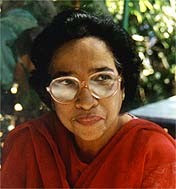.Manila on the eastern shore of the Manila Bay is the largest and most densely populated city in the Philippines. It was the scene of the bloodiest battle in the Pacific theatre during World War II, and was occupied by the Japanese from 1942-1945. The Philippine Guerilla Movement sabotaged Japanese communication lines, and assisted the American forces by providing information about secret tunnels and air raid shelters.
Among the members of the Resistance, was a young Filipino woman disfigured by leprosy, who shuffled through the streets of Manila. She carried on her ‘cloak and dagger’ activities in favour of the American forces, and was totally ignored by the unsuspecting Japanese.
Josefina Geurrero was once a pretty vivacious belle of Manila society. She was married to a wealthy medical student at St. Tomas University. Their daughter was two years old when Josefina contracted leprosy in 1941, and had to be confined to a leprosarium for treatment.
With the Japanese occupation of the Philippines, men were forced into labour camps, women were sent off to brothels, and the leprosariums were closed. Josefina used her disease as a secret weapon against the enemy. She was an outcaste and an untouchable, isolated from society. The Japanese were repulsed by her appearance and did not suspect her activities. Ragged and ugly, disease did not hamper her activities, and she had the run of the streets. She became a conduit for food, clothing and medicines to the American prisoners of war. As a member of the Resistance Movement, she was responsible for preparing maps of Japanese installations, aircraft batteries and fortifications on the waterfront. From her drawings, American planes were able to pinpoint targets and blast them to smithereens.
When the American troops arrived at Leyte, Joey (as she was fondly called by the Americans) carried a map of Japanese-held territory, showing locations of land mines on the planned route of the invasion. The map was taped to her back between her shoulder blades. Over this, she carried her back pack. Trudging 56 miles through Japanese encampments, Joey reached the 37th Infantry Division of the US army. This enabled them to avoid the mines as they marched towards Manila. She was awarded the Philippine Medal of Freedom for her courage. The US government bestowed on her the highest award given to a civilian – The Medal of Freedom with a silver palm.
Though leprosariums were reopened after the war, the Philippine government had no funds to run them. The US Attorney General Thomas Clarke waived immigration rules to bring Joey to a leprosarium in Carville, La. She was only thirty years old when she arrived in San Francisco. She was greeted by army officials, dignitaries and about 300 war veterans. The veterans’ band played the Philippine national anthem. Joey was overwhelmed by this display of gratitude. Her arms laden with flowers she smiled and said, “This is much more than I expected.”
Then an Air Force plane bore her away to Carville.
Among the members of the Resistance, was a young Filipino woman disfigured by leprosy, who shuffled through the streets of Manila. She carried on her ‘cloak and dagger’ activities in favour of the American forces, and was totally ignored by the unsuspecting Japanese.
Josefina Geurrero was once a pretty vivacious belle of Manila society. She was married to a wealthy medical student at St. Tomas University. Their daughter was two years old when Josefina contracted leprosy in 1941, and had to be confined to a leprosarium for treatment.
With the Japanese occupation of the Philippines, men were forced into labour camps, women were sent off to brothels, and the leprosariums were closed. Josefina used her disease as a secret weapon against the enemy. She was an outcaste and an untouchable, isolated from society. The Japanese were repulsed by her appearance and did not suspect her activities. Ragged and ugly, disease did not hamper her activities, and she had the run of the streets. She became a conduit for food, clothing and medicines to the American prisoners of war. As a member of the Resistance Movement, she was responsible for preparing maps of Japanese installations, aircraft batteries and fortifications on the waterfront. From her drawings, American planes were able to pinpoint targets and blast them to smithereens.
When the American troops arrived at Leyte, Joey (as she was fondly called by the Americans) carried a map of Japanese-held territory, showing locations of land mines on the planned route of the invasion. The map was taped to her back between her shoulder blades. Over this, she carried her back pack. Trudging 56 miles through Japanese encampments, Joey reached the 37th Infantry Division of the US army. This enabled them to avoid the mines as they marched towards Manila. She was awarded the Philippine Medal of Freedom for her courage. The US government bestowed on her the highest award given to a civilian – The Medal of Freedom with a silver palm.
Though leprosariums were reopened after the war, the Philippine government had no funds to run them. The US Attorney General Thomas Clarke waived immigration rules to bring Joey to a leprosarium in Carville, La. She was only thirty years old when she arrived in San Francisco. She was greeted by army officials, dignitaries and about 300 war veterans. The veterans’ band played the Philippine national anthem. Joey was overwhelmed by this display of gratitude. Her arms laden with flowers she smiled and said, “This is much more than I expected.”
Then an Air Force plane bore her away to Carville.








